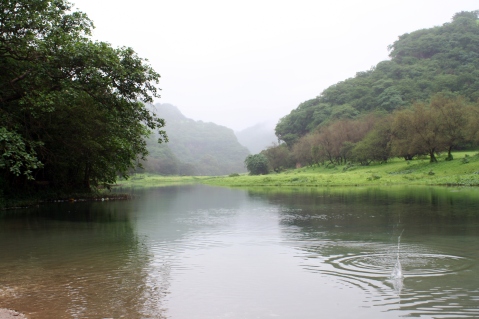Season of Plenty: Khareef!
During the annual ‘Khareef’ monsoon season, Dhofar’s mountains, valleys, coastlines and interior become rain soaked and shrouded in mist – presenting travellers with an enchanting world of natural greenery, water and blissfully cool temperatures…

From June through to September every year, the monsoon winds that blow inland over Salalah and the Dhofar coastline cause cool, moisture-laden air from the sea to rise up, and condense into thick fog and constant, light drizzle. The result is an explosion of green as the plants, grasses, trees, shrubbery and natural vegetation in the hills and valleys around Dhofar come to life – so much so that you’d be forgiven for thinking you’re in a tropical jungle in some parts. The streams and springs also come alive with the flow of water.
Khareef is the Arabic term used to describe this natural event. The word refers to the autumn season in which it occurs – but it also means ‘winds of plenty’. The blissfully cool temperatures in Dhofar during the summer months (they remain in the mid to low twenties during monsoon season) are a stark contrast to the rest of the country’s much warmer temperatures at this time of year. The overall sense of being part of a landscape that is bursting with life can have a profound effect on those experiencing it, and Dhofar and Salalah witness a massive influx of travellers over the Khareef season. But what adds even more allure to the idea of spending time in this region, are the fascinating array of cultural-historical and nature experiences on offer for the traveller.
1. Museum of the Frankincense Land: This museum provides a fascinating look at the history of Frankincense in Salalah.
2. Marneef Cave: Here, there are interesting cave formations and blowholes next to the sea.
3. Sumahram Old City: Legend has it that Sumharam was the fortress belonging to the Queen of Sheba.
4. The Frankincense Trail: The site includes frankincense trees, Khor Rori and the remains of a caravan oasis, which were all crucial to the medieval incense trade.
5. Nabi Ayoub’s Tomb: A small building encloses this important and revered tomb, which is set into the floor and draped with green silk cloth. (Also known as ‘Job’s Tomb’).
6. Salalah Museum: This small, well-kept museum documents Salalah’s history, as well as its maritime heritage.
7. Beaches: There are dozens of coves and bays to explore along the Dhofar coastline, and many kilometres of unspoilt beach.
8. Wadi Darbat: This is a natural park with majestic views of waterfalls, lakes, mountains, caves, wildlife and lush green vegetation.
9. Khor Rawri: Khor Rawri is one of the most scenic river valleys on the Arabian Peninsula.
10. Ain Homran: This natural spring is a paradise of beautiful greenery, water and rock formations. It is also an excellent spot for bird watching (several species of eagles have been identified here).
Ala Souq: Market Day
This much-loved souq is located in the middle of one of Salalah’s old neighbourhoods, and is famous for its high quality frankincense supplies, and traditional crafts like basketry, leatherwork, pottery, silverware etc. Photographers will love that it is also situated in an area that provides classic examples of Arabic architecture and design.
Frankincense and ‘The Perfume Capital’
Frankincense is a symbol of life for the Dhofari people. Dhofar was a major exporter of frankincense in ancient times, with some of it being traded as far away as China. To this day, Frankincense from Dhofar is prized for its quality. A bag of fine quality frankincense from ‘The Perfume Capital’ as Salalah is referred to, along with the set of paraphernalia used for burning it – Omani frankincense brazier, charcoals and tweezers – make a wonderful (and compact) travel souvenir to take home.
Reason to celebrate: The Salalah Tourism Festival
The Khareef Festival (officially the ‘Salalah Tourism Festival’) celebrates the fantastic, life-giving processes that this part of the world goes through every season. It also celebrates the people, customs, traditions and the remarkable, fascinating lifestyles that have been part of this great natural event since the earliest of times. The festival is held for around thirty days over July and August, and is a cultural extravaganza of folklore, dancing, music, crafts, art, photography, poetry, storytelling, theatre, and much more.

